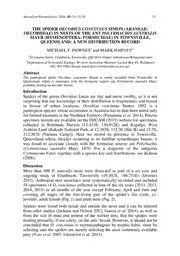
The spider Oecobius concinnus Simon (Araneae: Oecobiidae) in nests of the ant Polyrhachis australis Mayr (Hymenoptera: Formicidae) in Townsville, Queensland: A new distribution record PDF
Preview The spider Oecobius concinnus Simon (Araneae: Oecobiidae) in nests of the ant Polyrhachis australis Mayr (Hymenoptera: Formicidae) in Townsville, Queensland: A new distribution record
Australian Entomologist, 2016, 43 (1): 31-34 31 THE SPIDER OECOBIUS CONCINNUS SIMON (ARANEAE: OECOBIIDAE) IN NESTS OF THE ANT POLYRHACHIS AUSTRALIS MAYR (HYMENOPTERA: FORMICIDAE) IN TOWNSVILLE, QUEENSLAND: A NEW DISTRIBUTION RECORD MICHAEL F. DOWNES! and MARK HARVEY? 126 Canara Street, Cranbrook, Townsville, Old 4814 (Email: mikedownes@ bigpond.com) ° Department of Terrestrial Zoology, Western Australian Museum, Locked Bag 49, Welshpool DC, WA 6986 (Email: mark.@h muaseurm.vwa.egoyv.a u) Abstract The pantropical spider Oecobius concinnus Simon is newly recorded from Townsville in Queensland, where it associates with the formicine weaver ant Polyrhachis australis Mayr, probably feeding on the ants9 brood. Introduction Spiders of the genus Oecobius Lucas are tiny and move swiftly, so it is not surprising that our knowledge of their distribution is fragmentary and biased in favour of urban locations. Oecobius concinnus Simon, 1892 is a pantropical species whose occurrence in Australia has to date been noted only for limited locations in the Northern Territory (Framenau et al. 2014). Precise specimen records are available on the OZCAM (2015) website for specimens collected in Berrimah, Darwin (12.413S, 130.912E) and Kapalga, West Arnhem Land (Kakadu National Park, at 12.383S, 132.3E (Site B) and 12.7S, 132.367E (Naramu Camp)). Here we record its presence in Townsville, Queensland where, besides occurring in its familiar synanthropic haunts, it was found to associate closely with the formicine weaver ant Polyrhachis (Cyrtomyrma) australis Mayr, 1870. For a diagnosis of the subgenus Cyrtomyrma Forel, together with a species key and distributions, see Kohout (2006). Discussion More than 400 P. australis nests were dissected as part of a six-year and ongoing study in Cranbrook, Townsville (19.302S, 146.751E) (Downes 2015). Arthropod nest associates were systematically recorded and included 18 specimens of O. concinnus collected in four of the six years (2011, 2013, 2014, 2015) in all months of the year except February, April and June and covering all stages of the free-living part of the spider9s life cycle, i.e. juvenile, adult female (Fig. 1) and adult male (Fig. 2). Spiders were found both inside and outside the nests and it can be inferred from other studies (Jackson and Nelson 2012, Garcia et al. 2014), as well as from the size (6 mm) and armour of the worker ants, that the spiders were feeding primarily, if not solely, on the ants9 brood. However, it should not be concluded that O. concinnus is myrmecophagous by trophic habit, since by selecting ants the spiders are merely selecting the most commonly available prey (Voss et al. 2007, Liznarova et al. 2013). 32 Australian Entomologist, 2016, 43 (1) Figs 1-2. Oecobius concinnus, dorsal view: (1) adult female; (2) adult male. Sizes indicated by the 2 mm graph paper background. Australian Entomologist, 2016, 43 (1) 33 Nonetheless, the spider-ant association is unlikely to be simply fortuitous. One reason for this is that the ants9 brood is only accessible to predators that have some mechanism preventing the worker ants from recognizing the intruder as alien. Another is that spiders of the genus Oecobius are typically sit-and-wait webspinners, not free hunters (Glatz 1967, Voss et al. 2007), so their operating base would seem to be the ants9 nest. The spiders9 own web retreats, if constructed, are presumably either integrated into the ants9 nest or located close by. In this connection it is germane to note that the weaver ants also use spider silk, as well as silk from their own larvae, to construct their nests and line the interior (Dwyer and Ebert 1994). The lateral and marginal cephalothoracic spots, used in part by Santos and Gonzaga (2003) in their diagnoses of O. navus Blackwall, O. concinnus and O marathaus Tikader, would seem to be unreliable characters for species identification, given the clearly prominent elliptical laterals and triangular marginals of the Townsville specimens of O. concinnus. Structure of the male and female genitalia, as illustrated in Santos and Gonzaga (2003), remains the decisive diagnostic criterion. Adult female, adult male and juvenile specimens have been deposited in the Western Australian Museum, Perth. References CUSHING, P.E. 2012. Spider-ant associations: An updated review of myrmecomorphy, myrmecophily, and myrmecophagy in spiders. Psyche Article ID 151989, 23 pages. doi: 10.1155/2012/191859 . DOWNES, M.F. 2015. Annual cycle of nest composition in the queen-dimorphic weaver ant Polyrhachis australis Mayr, 1870 (Hymenoptera: Formicidae) in northern Queensland. Austral Entomology 54: 87-95. DWYER, P.D. and EBERT, D.P. 1994. The use of spider silk in the initiation of nest-building by weaver ants (Formicidae: Formicinae: Polyrhachis). Memoirs of the Queensland Museum 37: 115-119. FRAMENAU, V.W., BAEHR, B.C. and ZBOROWSKI, P. 2014. A guide to the spiders of Australia. New Holland, Sydney; 448 pp. GARCIA, L.F., LACAVA, M. and VIERA, C. 2014. Diet composition and prey selectivity by the spider Oecobius concinnus (Araneae: Oecobiidae) from Columbia. Journal of Arachnology 42: 199-201. GLATZ, L. 1967. Zur biologie und morphologie von Oecobius annulipes (Araneae, Oecobiidae). Zoomorphology 61: 185-214. JACKSON, R.R. and NELSON, X.J. 2012. Specialized exploitation of ants (Hymenoptera: Formicidae) by spiders (Araneae). Myrmecological News 17: 33-49. KOHOUT, R.J. 2006. Review of Polyrhachis (Cyrtomyrma) Forel (Hymenoptera: Formicidae: Formicinae) of Australia, Borneo, New Guinea and the Solomon Islands with descriptions of new species. Memoirs of the Queensland Museum 52: 87-146. LIZNAROVA, E., SENTENSKA, L., GARCIA, L.F., PEKAR, S. and VIERA, C. 2013. Local trophic specialisation in a cosmopolitan spider (Araneae). Zoology 116: 20-26. 34 Australian Entomologist, 2016, 43 (1) OZCAM. 2015. http://ozcam.ala.org.au/occurrences/search?taxa=Oecobius+concinnus# tab_mapView SANTOS, A.J. and GONZAGA, M.O. 2003. On the spider genus Oecobius Lucas, 1846 in South America. Journal of Natural History 37: 239-252. VOSS, S.C., MAIN, B.Y. and DADOUR, I.R. 2007. Habitat preferences of the urban wall spider Oecobius navus (Araneae, Oecobiidae). Australian Journal of Entomology 46: 261-268.
